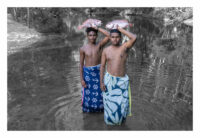![1 Naomi Hobson, [River Mermaid], 2019, from the series [Adolescent Wonderland].](https://photo.org.au/api/wp-content/uploads/2024/09/1-200x120.jpg)
Naomi Hobson, River Mermaid, 2019, from the series Adolescent Wonderland.
PHOTO Book Club – Brendan McCleary on Naomi Hobson's Adolescent Wonderland
16.9.24
Celebrating an extensive photo series, Naomi Hobson's debut photobook Adolescent Wonderland is brimming with joy - sharing snapshots of life along the river in her hometown of Coen, Cape York. PHOTO Australia Curator Brendan McCleary reflects on the book.
Goofy, Donald and Mickey, well masks of the three, smile surreally from a field of pink-blossoming grass. These masks are worn by three young Aboriginal men, staged within the landscape. This truly striking image is the cover for Southern Kaantju/Umpila woman Naomi Hobson’s Adolescent Wonderland, a series created in Coen, her hometown, in Cape York, far North Queensland. Wrapping around to the back cover, these three boys are joined by Daisy and Minnie, a quintet of smiling masks amidst the pink stained grassland.
![Screenshot 2024-09-12 at 3.57.21 PM Naomi Hobson, [Adolescent Wonderland], 2024](https://photo.org.au/api/wp-content/uploads/2024/09/Screenshot-2024-09-12-at-3.57.21 PM-200x83.png)
Naomi Hobson, Adolescent Wonderland, 2024.
Capturing the landscape, human interactions, friends and family, Adolescent Wonderland – the title referencing Alice’s spiral down the rabbit hole – is an invitation into a world of wonder. Colourful imagery serves as both a celebration of Naomi Hobson’s people, and a declaration of their identity, told through their own eyes.
The uplifting spirit captured in Adolescent Wonderland is abundant and unapologetic. Children wear cartoon masks, hold props, and wear coloured wigs, plunging the viewer into a world of boundless imagination. Photos are brimming with life, rich in colour and vibrancy, echoing the love, pride and joy that’s deeply embedded within the community and culture of Coen.
Everyday moments are elevated with props and hypercolour, transformed into memorable snapshots of beauty and happiness. In one image, two young boys stand in the river (one of them Naomi’s nephew) triumphantly holding red bream above their heads. This work featured in PHOTO 2022, commissioned specifically for the festival and displayed as a giant lightbox on the banks of the Birrarung.

Naomi Hobson, Fish Boys, 2022, from the series Adolescent Wonderland. Commissioned by Photo Australia for PHOTO 2022 International Festival of Photography. Courtesy the artist.
The river is a constant connector, flowing through the book, a reminder of its significance for the community – water as a site of play as much as it is a site of life. In one image, Sharkboy and sharkgirl stand ankle deep in the river, offering friendship to the reader.
![Screenshot 2024-09-12 at 3.48.54 PM Naomi Hobson, [Adolescent Wonderland], 2024.](https://photo.org.au/api/wp-content/uploads/2024/09/Screenshot-2024-09-12-at-3.48.54 PM-200x84.png)
Naomi Hobson, Adolescent Wonderland, 2024.
These images stand in sharp contrast to often negative stereotypes that permeate Australian culture, in Naomi’s words, “Adolescent Wonderland rejects stereotypes in mainstream culture that link ‘negativity’ and ‘badness” to the colour of our skin. When some people see our young black men and women they sense fear and then uncertainty. My people are a life full of humanity, strength and pride — and this has always inspired me.” Adolescent Wonderland breaks through these reductive views, celebrating these youth, and a true sense of fun.
In the opening pages to the book, Professor Marcia Langton AO’s contributes an essay, offering historical context about Coen and discussing the role that Aboriginal artists play in the realm of photomedia. Langton highlights the importance of these visual narratives, particularly in reclaiming and reshaping the representation of Indigenous life in Australian culture – truly considering what it is for practice to be self-determined. This is something Hobson is also keenly aware of, as she says, “I use photography to give my people a voice from the perspective of a black person speaking with black people”.
![4 Naomi Hobson, from the series [Adolescent Wonderland], 2024.](https://photo.org.au/api/wp-content/uploads/2024/09/4-200x144.jpg)
Naomi Hobson, from the series Adolescent Wonderland, 2024.
![5 Naomi Hobson, from the series [Adolescent Wonderland], 2024.](https://photo.org.au/api/wp-content/uploads/2024/09/5-200x144.jpg)
Naomi Hobson, from the series Adolescent Wonderland, 2024.
Adolescent Wonderland is a vibrant, playful book, serving as a powerful reminder to never forget the pure joy of childhood and the essential freedom of play. Through her lens, Hobson captures moments of adventure, connection, and community, showing a world of laughter, spontaneity, and deep-rooted relationships.